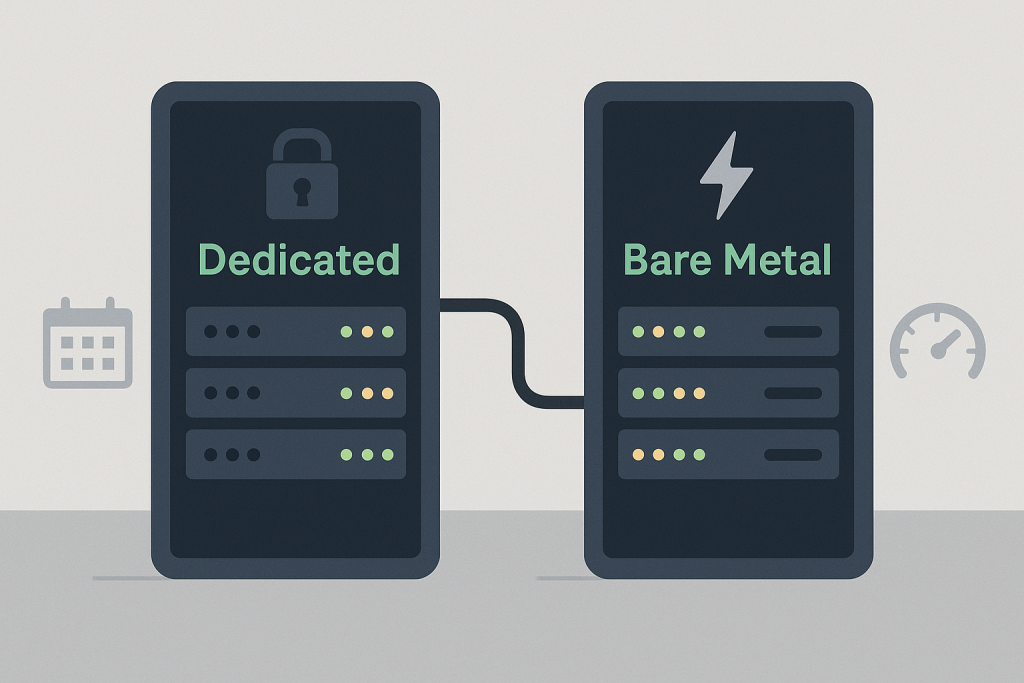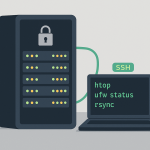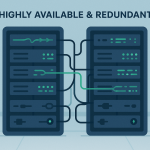Choosing the right kind of hosting for your website or application isn’t just a technical decision—it’s a fundamental business strategy. The choice you make impacts your performance, your security, your budget, and your ability to scale.
When you move beyond simple Shared Hosting or even a Virtual Private Server (VPS), you enter the world of Dedicated infrastructure. Here, the entire physical server is exclusively yours. This is where the confusion often begins, as two very similar-sounding terms appear: Dedicated Hosting and Bare Metal Hosting.
While many people, and even some hosting providers, use these terms interchangeably, there is a crucial, often subtle, difference that can dramatically affect your system’s performance, provisioning time, and ultimate cost. Think of it less like comparing apples to oranges and more like comparing two different breeds of a very powerful, single-tenant server.
This deep dive will cut through the technical jargon, clarify the distinction, break down the true pros and cons of each, and help you pinpoint the exact use case where one beats the other.
The Core Concept: Single-Tenant Servers
Before we look at the difference, let’s establish the common ground. Both Dedicated Hosting and Bare Metal Hosting are forms of single-tenant hosting.
Single-Tenant means one customer (you) is the sole user of the physical server hardware. You don’t share the CPU, RAM, or storage with anyone else. This is the opposite of multi-tenant environments like Shared Hosting or VPS, where virtualization slices up one physical server to serve many customers.
The fundamental benefits of single-tenancy apply to both Dedicated and Bare Metal:
- Guaranteed Resources: You get 100% of the server’s power, 100% of the time. No “noisy neighbor” effect.
- Enhanced Security: Physical isolation is the highest level of security. Your data is physically separate from other clients.
- Full Control: You choose the Operating System (OS), the software stack, and the security configurations.
The Key Distinction: Where the ‘Bare Metal’ Label Matters
The difference between Dedicated Hosting and Bare Metal Hosting, particularly in the modern hosting landscape, often comes down to how the server is provisioned (set up) and the presence (or absence) of a hypervisor.
| Feature | Traditional Dedicated Server | Bare Metal Server (Cloud-Era Term) |
| Hardware Access | Exclusive physical machine. | Exclusive physical machine (Direct Access). |
| Provisioning Time | Slower (often hours or days) – requires manual setup/configuration. | Faster (often minutes or under an hour) – relies on automation/APIs. |
| Virtualization Layer | May have a pre-installed virtualization layer (hypervisor) for easier management. | Always gives you the “bare” hardware, with no pre-installed hypervisor. You install your OS/Hypervisor. |
| Hardware Age/Tier | Tends to offer standard or older, stable enterprise-grade hardware. | Often features the latest, highest-end hardware (e.g., newest CPUs, NVMe storage). |
| Billing Model | Typically monthly or annual contract. Designed for long-term, stable use. | Often offers hourly or pay-as-you-go cloud-style billing. Designed for agility. |
| Management Focus | Often bundled with Managed Services by the host. | Often leans Unmanaged to give the user maximum control. |
1. The Hypervisor Question
This is the most critical technical difference.
- A Traditional Dedicated Server might come with a pre-installed hypervisor (a software layer that creates and manages Virtual Machines, like VMware or Hyper-V). The hosting provider might do this to make the server easier to manage or to offer you a way to easily spin up a few smaller virtual environments yourself.
- A Bare Metal Server, as the name suggests, provides you with the raw physical hardware—the bare metal—with no pre-installed operating system or hypervisor. You get to install the OS directly onto the hardware. This means zero virtualization overhead.
2. Provisioning and Billing (The Cloud Influence)
This is the key commercial difference that defines the modern Bare Metal server.
Traditional Dedicated Hosting is the “classic” model: you sign a contract, the host physically sets up or reconfigures a machine for you, and you pay a fixed monthly fee. It’s slow to set up, but predictable.
Bare Metal Hosting is often presented as Bare Metal as a Service (BMaaS). It is essentially dedicated hardware delivered with the speed, automation, and flexible billing of a public cloud. You can spin up a powerful server in minutes, often pay by the hour, and terminate it when you’re done. This combination of dedicated power with cloud agility is what makes “Bare Metal” a distinct, premium offering.
Deep Dive: Pros and Cons
Let’s weigh the specific advantages and disadvantages of each type of hosting.
🍎 Dedicated Hosting: The Stable Workhorse
A Traditional Dedicated Server is the reliable, long-term solution for established businesses with predictable resource needs.
Pros of Dedicated Hosting
| Advantage | Explanation in Simple English |
| Predictable Cost | You pay a flat, stable monthly rate. This makes budgeting and financial planning incredibly simple and avoids the variable charges of cloud models. |
| Hardware Stability | The hardware configuration is often fixed for the duration of your contract (e.g., 1-3 years). This stability is perfect for mission-critical apps that need an unchanging environment. |
| Managed Options | Dedicated hosting is often offered as a fully managed service, meaning the host handles maintenance, patching, security, and hardware failures. This drastically reduces your IT team’s workload. |
| Less Complexity | Because it is often pre-configured, you don’t have to worry about low-level hardware or hypervisor configuration; you just focus on your application. |
Cons of Dedicated Hosting
| Disadvantage | Explanation in Simple English |
| Slower Provisioning | Setting up a new server or majorly upgrading hardware usually requires human intervention and can take hours or even days. |
| Limited Scalability | Scaling means buying a bigger physical box (vertical scaling), which requires downtime and a contract change, or adding another box (horizontal scaling), which is a manual process. |
| Potential for Older Hardware | To keep costs low and service stable, the provider might use older, proven hardware that isn’t the absolute latest technology. |
| Virtualization Overhead (If Used) | If the host installs a hypervisor for management, a small fraction of the server’s CPU and RAM is consumed by that software layer, slightly reducing peak performance. |
⚙️ Bare Metal Hosting: The Performance Powerhouse
A Bare Metal Server (especially the modern, cloud-integrated version) is for those who need the ultimate performance combined with a level of cloud-like speed and flexibility.
Pros of Bare Metal Hosting
| Advantage | Explanation in Simple English |
| Maximum Raw Performance | This is the biggest selling point. Since there is no hypervisor, there is zero overhead. 100% of the server’s power goes to your application, resulting in the lowest latency and highest throughput possible. |
| Access to Latest Hardware | Bare Metal plans are often where hosts showcase their newest technology, including the fastest NVMe SSDs, cutting-edge GPUs, and top-tier processors. |
| Rapid Provisioning | Automation and API-driven setup mean you can deploy a new server in minutes, not days. This is a game-changer for testing, staging, and urgent capacity needs. |
| True Hourly Billing | The “pay-as-you-go” model is ideal for temporary or burstable workloads. Need immense power for a week-long data crunching job? Spin it up, use it, and turn it off. |
| Unrestricted Customization | You have complete, low-level control. You can install an OS that the provider doesn’t officially support, or run a complex, nested virtualization setup perfectly tuned to your needs. |
Cons of Bare Metal Hosting
| Disadvantage | Explanation in Simple English |
| Higher Cost | The combination of premium hardware and flexible cloud-style pricing usually results in a higher overall price compared to a standard dedicated server, especially for long-term, static use. |
| Management Burden | Since the goal is unrestricted control, most Bare Metal is unmanaged. You, or your team, are fully responsible for the OS, patching, security updates, and monitoring. |
| Potential for Underutilization | You rent the whole box. If your application only uses 50% of the server’s power, the other 50% is idle capacity that you are still paying for. |
| Setup Complexity | Installing an OS directly onto bare metal requires deep technical knowledge of networking, drivers, and server hardware, which is beyond the skills of a typical webmaster. |
The Verdict: Bare Metal vs Dedicated Hosting Use Cases
Choosing between these two powerhouses requires looking at your workload, your budget, and your need for control versus convenience.
🎯 Choose Traditional Dedicated Hosting If:
Dedicated Hosting is the right choice for workloads that are stable, predictable, long-term, and where convenience, management, and cost predictability are more important than razor-thin performance margins.
Typical Use Cases for Dedicated Hosting:
- Established E-Commerce Platforms (Stable Traffic): A successful online store with predictable year-round traffic needs the reliability and guaranteed resources of dedicated hosting. The stable cost is a major benefit for business planning.
- Why not Bare Metal? The store doesn’t need to scale on a moment’s notice, and the budget benefits from a lower, fixed monthly cost.
- Corporate Applications and Internal Servers: Hosting internal tools, ERP (Enterprise Resource Planning), CRM (Customer Relationship Management) software, or high-volume email servers. These applications demand a stable, isolated environment but don’t typically have sudden, massive spikes in resource demand.
- Why not Bare Metal? Management simplicity and stability over raw, burst performance.
- High-Traffic, Standard Websites and Blogs: A media company or major publisher with consistent, non-bursting high traffic that needs more power than a VPS but doesn’t have extreme, performance-critical computational demands.
- Managed Environments: You have a small or no in-house IT team and rely entirely on your hosting provider to handle the day-to-day server maintenance and infrastructure security.
🚀 Choose Bare Metal Hosting If:
Bare Metal Hosting is necessary for workloads that are hyper-performance critical, burstable, require specialized hardware, or where low-latency and maximum resource control are paramount.
Typical Use Cases for Bare Metal Hosting:
- Big Data, AI, and Machine Learning: Processing massive datasets, training complex AI models, or running sophisticated data analytics requires the highest possible processing power, GPU (Graphics Processing Unit) access, and I/O (Input/Output) speed. The absolute lack of virtualization overhead is critical.
- Why not Dedicated? Bare Metal offers newer, faster, and often specialized hardware (e.g., specific GPUs) and the freedom to install custom low-level software stacks.
- High-Frequency Trading and Financial Applications: These systems rely on ultra-low latency (speed) to execute trades. Every millisecond counts. Direct hardware access ensures the fastest possible network and data processing speed.
- Why not Dedicated? The minor performance hit from a hypervisor is unacceptable in this time-critical environment.
- Large-Scale Gaming and Streaming Servers: Massive multiplayer online games or real-time video streaming need consistent, low-latency performance to prevent lag. Bare Metal guarantees all resources are dedicated to serving the high concurrent user count.
- Resource-Intensive Virtualization/Container Hosts: If you plan to run your own large-scale virtualized environment (a private cloud) or a massive Kubernetes cluster, you should run the hypervisor/container platform directly on the bare metal. This avoids the severe performance degradation of nested virtualization (running a VM inside a host that is already a VM).
- Temporary, High-Burst Workloads: A seasonal e-commerce site that needs 10x the power for one month during Black Friday, or a company running a week-long simulation. The hourly, on-demand billing model of Bare Metal makes this power acquisition extremely agile and cost-effective.
- Strict Compliance Requirements (The Cloud-Integrated Model): For industries like finance or healthcare (HIPAA, PCI-DSS, etc.), the isolation of a single-tenant environment is non-negotiable. Modern Bare Metal, often integrated with a public cloud network, allows them to meet these strict compliance needs while benefiting from the surrounding cloud services.
Final Takeaway: The Hybrid Approach
In the real world, many sophisticated organizations don’t choose one or the other—they choose both, creating a hybrid infrastructure.
- They use Traditional Dedicated Servers for their core, long-term, stable applications (CRM, primary database, internal tools). This keeps costs predictable and management simple.
- They use Bare Metal Servers for their high-performance, short-term, or burstable needs (AI model training, Black Friday traffic spikes, specialized testing environments). This provides on-demand power and flexibility.
The best hosting solution is the one that aligns most closely with your application’s resource profile and your business’s budget, technical expertise, and growth strategy. Don’t pay a premium for features you don’t need, but never compromise performance on a mission-critical workload.



